ISSN ONLINE(2319-8753)PRINT(2347-6710)
ISSN ONLINE(2319-8753)PRINT(2347-6710)
Darshan Kumar.C.D1, Asha Rani.N2
|
| Related article at Pubmed, Scholar Google |
Visit for more related articles at International Journal of Innovative Research in Science, Engineering and Technology
Present work deals with the study of physico-mechanical behaviour of Polypropylene matrix reinforced with a wood flour as a filler material and decabromodiphenyl oxide as a flame retardant. The PP has excellent mechanical properties, WF has high elastic modulus but less fire resistance so in order to improve the fire resistance the decabromodiphenyl oxide is used as a flame retardant .The PP/WF/FR fabricated composites have been evaluated for the physicalmechanical properties such as specific gravity, surface hardness, water absorption, tensile behaviour, flexural behaviour and impact strength. It was found that the tensile strength of virgin PP was 36.4MPa and that of composites lies in the range 31.4- 35.1MPa. The FR additive incorporated composites helps to enhance the flammability property but shows a slight reduction in tensile strength, however the tensile modulus increased.
Keywords |
| PP (Polypropylene), WF (wood flour), DCO (decabromodiphenyl), FR (flame retardant), PP-g-MA (maleic anhydride grafted PP), WPC (wood plastic composites) |
INTRODUCTION |
| The traditional method to modify the performance of thermoplastic by the plastic industry uses inorganic fillers such as talc, calcium carbonate, mica, glass and carbon fibers. Recently, organic fillers produced from wood or agricultural plants have gained tremendous attention from plastic industry [1-2]. Agricultural plants are a good source of raw material for organic fillers. Several studies were conducted to manufacture thermoplastic composites using WF or fiber including hemp, flax, jute, sisal and ramie [3-10]. |
| The elastic modulus of wood flour filler is approximately 40 times higher than that of PP and the strength is about 20 times higher but wood flour results in low thermal behaviour [11]. The PP matrix is already used in many industrial application. Toy industries have investigated a research in this area, utilizing the PP with WF filler [12]. Currently the more used reinforcements in the industry are the synthetic fibers, because of its good physical and chemical properties. On the other hand these materials have problems related to the discarding, therefore they are not bio degradable and are harmful to the environment. So researchers deal with the substitution of synthetic fiber by the natural fiber such as coconut, sisal, bamboo etc [13-15]. Wood- polypropylene are typically used in automotive applications and consumer products and these components have recently been investigated for use in building profiles [16]. |
FABRICATION OF COMPOSITES |
| The fabrication of DCO and WF loaded with PP composite and the effect of DCO on the performance of PP/ WF were investigated. The formulation of the composites are shown in Table 1.1. A series of composites with varying amounts viz., 0, 3, 6 and 9 wt % of FR along 30 wt % of WF +filler filled PP composites have been fabricated by melt mixing method. During the fabrication of composites 3% PP-g-MA was used as a compatibilizer between PP and WP. The ratio of PP-g-MA was kept constant at the level of 3% for all PP composites. |
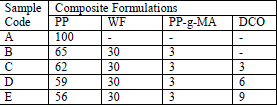 |
RESULTS AND DISCUSSION |
| PHYSICAL PROPERTIES |
| SPECIFIC GRAVITY |
| The calculated average specific gravity of the composites is shown in the Table 1.2. The specific gravity of the composites varied from 1.016 to 1.093 as compared to 0.896 for virgin PP. It is clear that the addition of WF and FR increased the specific gravity of the PP matrix. In WPC, increase in specific gravities may result in better dispersion of fiber bundles, polymer penetration into hollow fibers or better bulk packing due to increased fiber alignment of WF filler. |
| WATER ABSORPTION |
| The water absorption of neat virgin PP was 0.01% and for composites it lies in the range 1.28-1.41% in ambient temperature and at boiling water temperature the water absorption of virgin PP was 0.08% and for composites it lies in the range 2.1-3.3 %. The solution diffusion of water through composites results in higher water uptake behaviour at the surface than in the core which augments the problem of decay in properties of the composites. The water absorption of WF filled composites is mainly because of the presence of lignocellulosic filler. The water which absorbed tends to retain in the inter fibrillar space of the cellulosic structure of these fillers as well as flaws at the interface and micro voids present in the composites. |
| SURFACE HARDNESS |
| Surface hardness is a measure of resistance to penetration. The measured surface hardness of virgin PP and composites are given in Table 1.2. The surface hardness of virgin PP is 65 shore D, whereas for composite it is 73.5 shore D. The surface hardness values of composites lies in the range 71.5 to 73.0 shore D. The average surface hardness increased significantly with addition of WF filler. This is because WF is organic filler and is rigid in nature, which is expected to increase the stiffness of the composites. |
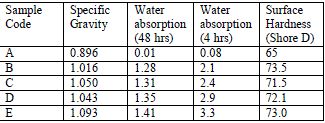 |
MECHANICAL PROPERTIES |
| The mechanical properties of composites plays a vital role in most of the load bearing applications. The demand for composite materials is increased in aeronautical, civil, automobile and structural application. The mechanical properties of PP/WF/FR composites were discussed under 3 headings, tensile, flexural, and impact strength |
| Tensile Strength |
| The measured tensile properties of FR incorporated composites are presented in Table 1.3 |
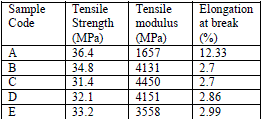 |
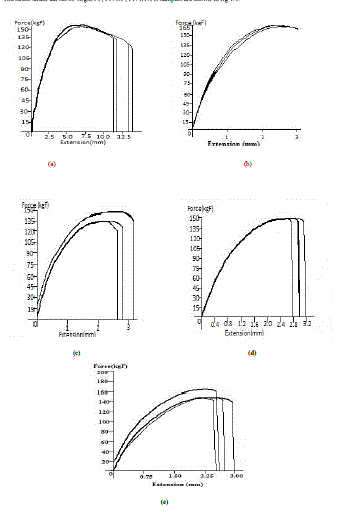 |
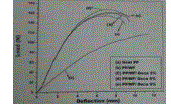 |
| The addition of WF decreased the tensile strength of the composite compared to the virgin PP from table 1.3 it was found that the tensile strength of virgin PP and PP/WF were 36.4 and 34.8MPa respectively.The tensile strength of PP/WF/FR lies in the range 31.4-33.2 MPa. It is noted that decrease in the tensile strength with increase of 30 wt % of WF. |
| From table 1.3 it was found that tensile modulus of virgin PP is 1657 MPa and that of PP/WF composite is 4131 MPa.it is noted that PP/WF composite exhibit steep increase in tensile modulus than virgin PP because due to the restriction in molecular mobility or deformation of PP by WF particles accounted for the increase in modulus of the composites. The tensile modulus of PP/WF/FR lies in the range 3558-4450 MPa. The incorporation of FR (DCO) into PP/WF shows increase in tensile modulus of the composite. The percentage elongation of PP is 12.7, whereas PP/WF and PP/WF/FR were 2.7 results in drastically reduction in elongation after incorporation of 30 wt % WF into PP. |
FLEXURAL PROPERTIES |
| The plot of deformation curves for all PP/WF composites is shown in fig 2. |
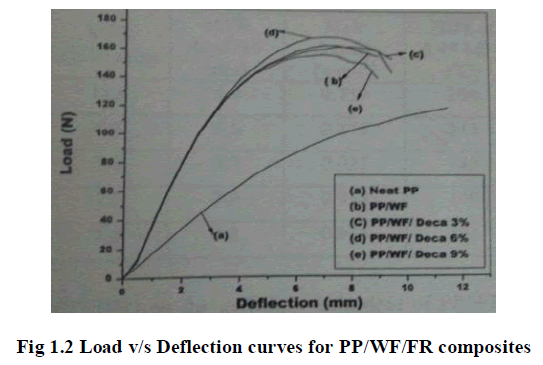 |
| The flexural results clearly indicate a significant improvement in flexural strength after incorporating WF and DCO (FR) into PP matrix. It was observed that the flexural strength of virgin PP and PP/WF, PP/WF/FR were 25.6 and 47.6 MPa respectively (Table 1.4). The virgin PP had an average flexural modulus of 1650 MPa and incorporating 30 wt % WF into PP matrix enhance the flexural modulus drastically. The incorporation of FR into PP/WF noticed a improvement in the flexural modulus values with increase in flame retardant and the values lies in the range of 3312- 3328 MPa (Table 1.4) |
| IZOD IMPACT STRENGTH |
| The Izod impact test is widely used for characterization of impact toughness. The effect of FR on the notched impact strength values of virgin PP and PP/WF composites are presented in table 1.4. from the table it was found that the izod impact strength of virgin PP was 22.3 J/m and that of PP/WF was 18.4 J/m. the addition of WF reduced the impact strength value, this is because WF filler disturbs matrix continuity and each filler particle is a site of stress concentration and also act as a micro crack initiator. The impact strength values for PP/WF/FR were found to increase from 22.4 to 24.7 J/m (from 3% to 9% DCO). The addition of DCO (FR) into PP/WF showed marginal improvement in impact strength value. Impact strength increases with increase in FR to PP/WF composite. |
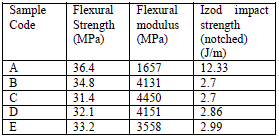 |
CONCLUSIONS |
| In this work, an attempt was made to utilize WF resources and reduce carbon footprints of plastics. After incorporation of WF the water absorption behaviour of composites increased because of WF which is Hydrophilic in nature. Tensile strength of composites was decreased from 36.4 to 31.8 MPa and modulus from 1657 to 4450 MPa after incorporation of WF into PP matrix. Percentage elongation was reduced drastically from 12.3 to 2.7 %. Both flexural strength and modulus values showed two fold improvement compared to virgin PP. Toughness measured by izod impact strength showed marginal increment. |
References |
|